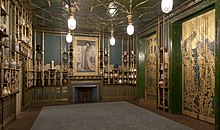
Back الحركة الجمالية Arabic Estetçilik Azerbaijani Естетизъм Bulgarian নান্দনিকতা Bengali/Bangla Esteticisme Catalan Esthetiaeth Welsh Ästhetizismus German Αισθητισμός Greek Estetikismo Esperanto Esteticismo Spanish

Aestheticism (also known as the aesthetic movement) was an art movement in the late 19th century that valued the appearance of literature, music, fonts and the arts over their functions.[1][2] According to Aestheticism, art should be produced to be beautiful, rather than to teach a lesson, create a parallel, or perform another didactic purpose, a sentiment best illustrated by the slogan "art for art's sake." Aestheticism flourished in the 1870s and 1880s, gaining prominence and the support of notable writers such as Walter Pater and Oscar Wilde.
Aestheticism challenged the values of mainstream Victorian culture, as many Victorians believed that literature and art fulfilled important ethical roles.[3] Writing in The Guardian, Fiona McCarthy states that "the aesthetic movement stood in stark and sometimes shocking contrast to the crass materialism of Britain in the 19th century."[4]
Aestheticism was named by the critic Walter Hamilton in The Aesthetic Movement in England in 1882.[5] By the 1890s, decadence, a term with origins in common with aestheticism, was in use across Europe.[3]
- ^ Fargis, Paul (1998). The New York Public Library Desk Reference – 3rd Edition. Macmillan General Reference. pp. 261. ISBN 0-02-862169-7.
- ^ Denney, Colleen. "At the Temple of Art: the Grosvenor Gallery, 1877–1890", Issue 1165, p. 38, Fairleigh Dickinson University Press, 2000 ISBN 0-8386-3850-3
- ^ a b "Aestheticism and decadence". British Library. Retrieved 2 August 2020.
- ^ "The Aesthetic Movement". The Guardian. Retrieved 1 September 2020.
- ^ "Aesthetic Movement". Tate. Retrieved 1 September 2020.
© MMXXIII Rich X Search. We shall prevail. All rights reserved. Rich X Search